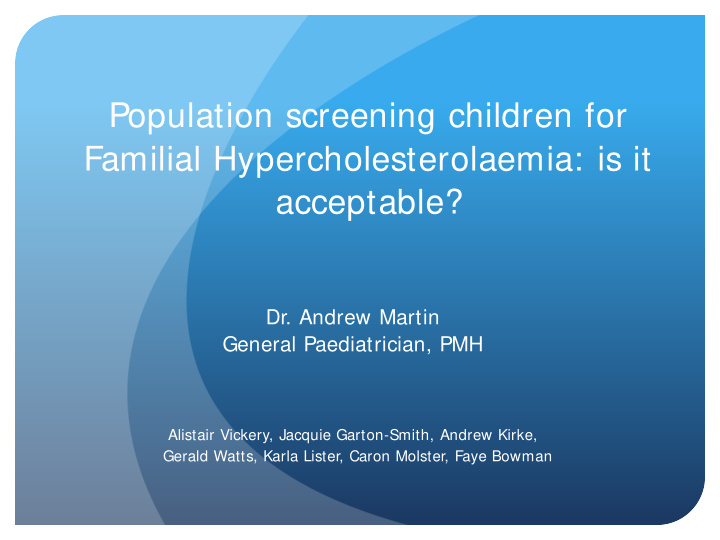



Population screening children for Familial Hypercholesterolaemia: is it acceptable? Dr. Andrew Martin General Paediatrician, PMH Alistair Vickery, Jacquie Garton-Smith, Andrew Kirke, Gerald Watts, Karla Lister, Caron Molster, Faye Bowman
Familial Hypercholesterolaemia Common (1:300), potentially lethal, but treatable > 80% of those affected unaware LDL-cholesterol 2 x normal from birth Untreated 50% men & 20% women MI < 50 yrs Autosomal dominant inheritance Cascade screening
Diagnosis of FH in adults Needs to be considered! Scores based on family history, LDL-C level, clinical signs Dutch Lipid Clinic Network Criteria (www.athero.org.au/FH/calculator) Simon Broome Criteria
Clinical Manifestations of FH Gillett MJ and Burnett JR. Intern Med J 2005
Diagnosis of FH in children More difficult! Usually follows cascade screening after diagnosis of parent Parent definite FH (if mutation known then test) LDL-C < 75 th percentile (2.8mmol/L) - unlikely FH LDL-C > 95 th percentile (3.5mmol/L) – probable FH LDL-C > 5mmol/L definite FH
Management of children with FH When to test children who have a parent with FH? Around 5-8 years? Decide with parents When to start treatment in children? Generally 8-10 years Clinical judgment: LDL-C, family history and parental views Are current drugs safe in children? Statins have same low level of bad side effects as adults Good short term safety (growth, puberty) Long term safety confirmed up to 10 years
FH in children: the current situation Approximately 8,000 West Australians affected 1,600 children < 16 years with FH in WA After 7 yrs FHWA only 50 children identified (< 5%) Additional 100 children born every year with FH in WA Need a better way to detect children with FH!
Population screening for FH
WHO principles for screening 1968 Wilson & Jungner ∗ The condition should be an important health problem. ∗ There should be a treatment for the condition. ∗ Facilities for diagnosis and treatment should be available. ∗ There should be a latent stage of the disease. ∗ There should be a test or examination for the condition. ∗ The test should be acceptable to the population. ∗ The natural history of disease adequately understood. ∗ There should be an agreed policy on whom to treat. ∗ The total cost of finding a case economically balanced in relation to medical expenditure. ∗ Case-finding continuous process, not "once and for all" project.
Population screening for FH LDL-cholesterol at time of an immunisation Pre-school booster (4yrs) or HPV vaccine (12yrs) LDL > 4.5mmol/L probable FH Reverse cascade screen through family Appears feasible, but is it acceptable? Many other conditions amenable to screening
Aims Acceptability of screening children for FH by general population, GP’s, practice and immunisation nurses Preference of general population, GP’s, practice and immunisation nurses to screen children at 4yrs or 12 yrs
Next steps If population screening acceptable undertake pilot study to confirm feasibility
Acknowledgements Professor Alistair Vickery, Dr Jacquie Garton-Smith, Dr Andrew Kirke Professor Gerald Watts Karla Lister, Caron Molster, Faye Bowman Princess Margaret Foundation Grant
Questionnaire
Recommend
More recommend